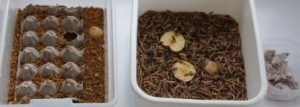Mike & I recently had special access to an important new initiative by Conservation Halton. We were allowed inside the newly built breeding facility for Eastern Loggerhead Shrikes, at Mountsberg Conservation Area, for Mike to take photographs. Except for the one above, these photos are all by (and copyright of) Mike Davis.
The Eastern Loggerhead Shrike is an endangered species of bird, and with only 21 wild pairs seen by last year, it is on the edge of extinction. As part of a large Shrike recovery program, this facility is sheltering paired Shrikes in order to breed and release hatchlings into the wild.

This is the good news. The bad news for the public is that visitors won’t be able to get close to see these birds in the facility. The breeding program is so critical and so new, that nothing and no one should disturb or frighten the Shrikes from their important job of surviving and restoring their species.
So let us give you a behind-the-scenes look at the facility. First, some details: “Eastern Loggerhead Shrikes are a predatory, robin-sized songbird that prefers short grasslands or grazed pastures,” notes Conservation Halton. “They hunt small animals, such as rodents, insects, other small birds, and amphibians.” Shrikes have strong hooked beaks that can quickly kill prey, but they don’t have strong legs or talons to hold onto it while feeding. They developed a technique of impaling their dead prey on a thorn to hold it while they tear it apart, or store it for later. This unique behaviour has caused them to be known as the “butcher bird.” At Mountsberg, the Shrikes’ diet consists of dead mice, live crickets and two kinds of live worms.


Inside the Mountsberg facility, one Shrike has become used to its feeders, especially Amy Fennell, and has been named Jack the Ripper. Jack moves about very quickly, and lighting was a problem, so Mike didn’t get a great shot. Here’s one of his that shows Jack’s hooked beak, if you can see it.

Mike noticed something unusual at the inside top of Jack’s pen. When he asked Amy, she said she hadn’t seen them before, and they were pellets, or waste material that birds regurgitate. She was very interested to see them and said they were another good sign of Jack’s acceptance of his new surroundings.

For more information on the Shrike recovery program, see Wildlife Preservation Canada and Conservation Halton Foundation (Click on “Shrike Recovery Project” on the left menu.). Canadian Wildlife Service is also involved, but their website is being reorganized and I couldn’t find a useful link.
Do you have anything to add about this project?
Important addition: here’s a great video of Amy giving a tour of the new facility. So interesting, it’s almost like being there!







